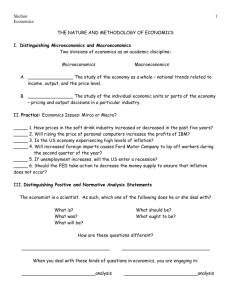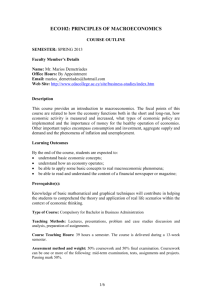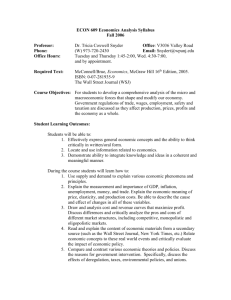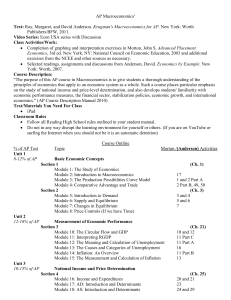Course Outline
advertisement
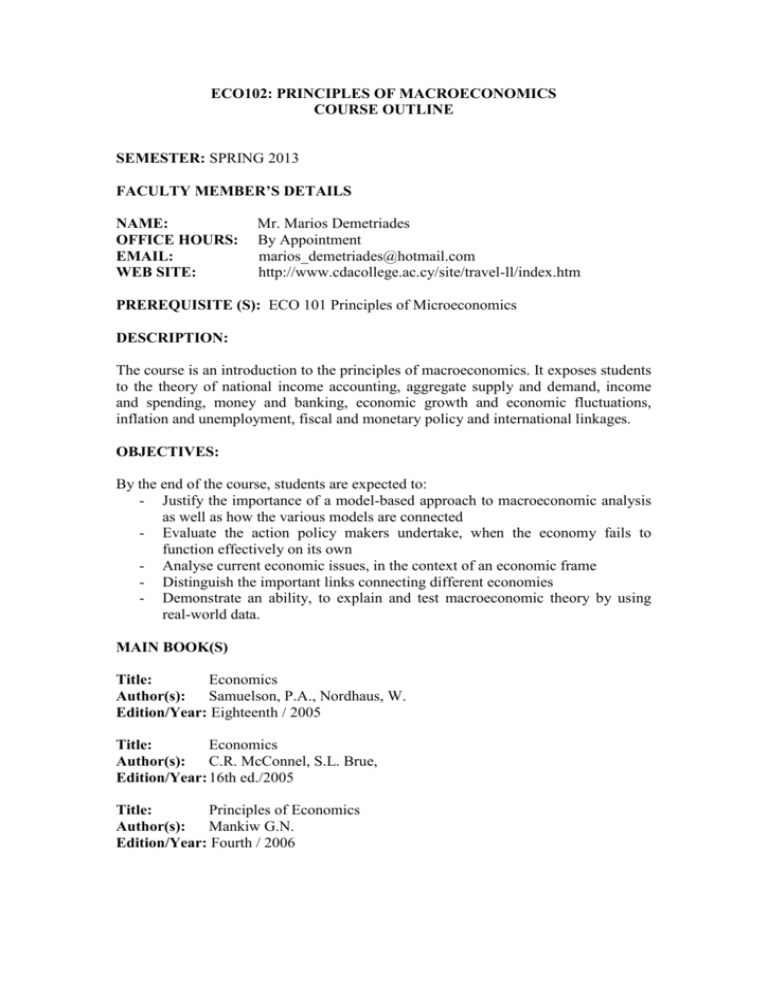
ECO102: PRINCIPLES OF MACROECONOMICS COURSE OUTLINE SEMESTER: SPRING 2013 FACULTY MEMBER’S DETAILS NAME: OFFICE HOURS: EMAIL: WEB SITE: Mr. Marios Demetriades By Appointment marios_demetriades@hotmail.com http://www.cdacollege.ac.cy/site/travel-ll/index.htm PREREQUISITE (S): ECO 101 Principles of Microeconomics DESCRIPTION: The course is an introduction to the principles of macroeconomics. It exposes students to the theory of national income accounting, aggregate supply and demand, income and spending, money and banking, economic growth and economic fluctuations, inflation and unemployment, fiscal and monetary policy and international linkages. OBJECTIVES: By the end of the course, students are expected to: - Justify the importance of a model-based approach to macroeconomic analysis as well as how the various models are connected - Evaluate the action policy makers undertake, when the economy fails to function effectively on its own - Analyse current economic issues, in the context of an economic frame - Distinguish the important links connecting different economies - Demonstrate an ability, to explain and test macroeconomic theory by using real-world data. MAIN BOOK(S) Title: Economics Author(s): Samuelson, P.A., Nordhaus, W. Edition/Year: Eighteenth / 2005 Title: Economics Author(s): C.R. McConnel, S.L. Brue, Edition/Year: 16th ed./2005 Title: Principles of Economics Author(s): Mankiw G.N. Edition/Year: Fourth / 2006 Title: Macroeconomics Author(s): Mankiw G.N. Edition/Year: Sixth / 2007 ADDITIONAL READING AND OTHER LEARNING RESOURCES Websites Library of Economics Homepage: www.econlib.org Economics About Homepage: economics.about.com Journals American Economic Review Quarterly Journal of Economics Journal of Macroeconomics Periodicals Financial Times The Economist SCHEDULE WEEKS TOPICS 1 The Fundamentals of Macroeconomics Overview of Macroeconomics: Aggregate Supply and Demand; Macroeconomic Issues; Objectives and Instruments. Measure National output: the Yardstick of An Economy; Performance; Details of the National Accounts. ACTIVITIES Discussion, Questions, Applications and Examples 2 Consumption and Investment Discussion, Consumption and saving: Marginal propensities; the Questions, Instability of Investment. Applications and Examples 3 Theory of Output Determination The Theory of Output Determination: Classical and Keynesian Approaches to Output Determination; the Multiplier Model; the Paradox of Thrift; the Making of Fiscal Policy. Discussion, Questions, Applications and Examples. 4 Business Cycles and Aggregate Supply and Demand Aggregate Supply and Business Cycles: Determinants of Aggregate Supply: Okuns Law; Supply – Side Economics; Business Cycles Theories; Forecasting Business Cycles. Discussion, Questions, Applications and Examples 5 Unemployment Analyze Unemployment: Importance of Unemployment; Measuring Unemployment; Economic Interpretation of Unemployment. Discussion, Questions, Applications and Examples Revision of Mid Term material 6 7 8 Mid-Term Examination Inflation Inflation: Definitions and Costs; Causes and Cures; What is Inflation; the Impact of Inflation; Analysis of Discussion, Inflation’s Costs; Alternative Sources of Inflation; the Questions, Philips Curve; Open Issues; Incomes Policy. Applications and Examples Money, Commercial Banking and Monetary Policy Discussion, Money and Commercial Banking; Central Bank and Questions, Monetary Policy, History of Money and Banks, Banking Applications as Business; the Process of Creation of Bank Deposits; and Examples How Monetary Policy Works to Control Spending; How Control Banking Works; the Nuts and Bolls of Monetary Policy. 9 Policies for Growth and Stability Monetarism and the Demand for Money: the Demand for Money: How Money Affects Output; MonetarismModern Monetarism; the Rational Expectations Postulates. The Fiscal-Monetary Mix and Government Deficits: Modern Public Finance; the Fiscal Monetary Mix; Do Deficits Crowd of Investment; Measuring and History of Government Debts. 10 The economic role of the government- The process of Discussion, economic growth and development Questions, Applications Economic Role of Government: the Growth and and Examples Functions of Government; Public Choice; Government Expenditures; Principles of Taxation: the Theory Problem of Tax Incidence. The Theory of Economic Growth; the Trends and Sources of Economic Growth; The Economics of Developing Countries; Population Economic Condition; Theories of Economic Development. International Trade Discussion, International Trade and the Theory of Comparative Questions, Advantage; the Gains from Trade and the Law of Applications Comparative Advantage; the Balance of International and Examples Payments. 11 Discussion, Questions, Applications and Examples 12 13 Economics of Protectionism Protective Tariffs: Quotas and Free Trade; Supply and Demand Analysis of Trade and Tariffs; the Economics of Protectionism. Discussion, Questions, Applications and Examples Exchange Rates and the International Financial Submission of System Assignment, Discussion, Exchange Rates and the International Financial System; Questions, Mechanisms of Foreign Exchange and Trade; Three Applications Major Exchange Rate Systems; Macroeconomics of and Examples Open Economies; Breakdown and Reconstruction of The International System. Revision Estimated Student workload: Activity Class attendance Independent Study Mid – Term Exam Preparation, Assignment Preparation, Test Preparation, Exercises Preparation Final Exam and Final Exam Preparation Total Hours 42 39 33 36 150 ASSESSMENT Class Participation/Tests and assignments: 25% Mid-term examination: 25% Final examination: 50% In evaluating the quality of your class participation, I will consider: 1st your attitude towards the course material; 2nd how well you prepare your homework assignments; 3rd how often you participate in the debate and class activities Assignments: Assignments may be given at the end of each class. Additionally an assignment will be given after the mid-term examination, concerning the chapters of supply and demand to be delivered by the date of the final examination. Mid-term examination: The mid-term examination will be of two hours. It will mostly be essay questions and/or multiple-choice questions. Final Examination: The final examination will be of two and a half hours. It will be comprehensive and it will test the students on the material covered during the semester. The exams will consist of a section of identifications - in which you will write brief definitions and describe the relevance of key concepts, theories, etc. -, a section with simple calculus and an essay section. The first two sections may contain multiplechoice or True/False questions. NOTES: Class attendance and participation in class discussion is expected and absences will affect your final grade. The due dates for assignments are non-negotiable and late work will be penalized. All assignments are to be professional in appearance and type. B.A in Travel and Tourism Management Grading System: % Grade Grade 90-100 80-89 75-79 65-74 60-64 55-59 50-54 Below 50 A B+ B C+ C D+ D F Grade Meaning Grade Points per Credit Excellent 4.00 Very Good 3.50 Good 3.00 Above Average 2.50 Average 2.00 Below Average 1.50 Poor 1.00 Failure 0.00 OTHER INFORMATION Class attendance: Students must maintain a 70% attendance throughout the semester. Humane matters: Students should inform their faculty member for any unforeseen matters that may occur, which may prevent them from fulfilling what is expected in the frame of the course. Library: The students are advised to visit the library of the College on a regular basis and read articles published in academic journals. It is recommended that the expertise of the College’s librarian is exploited by the students by enquiring for help, so as to become fully aware of the facilities and search techniques offered by the library and how these can be utilised by the students in a fruitful way. It is recommended that study of articles published in international journals as well as financial newspapers and magazines is regularly undertaken.

